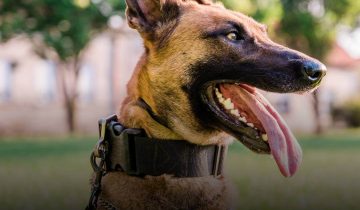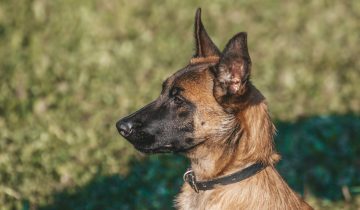If you have considered getting a working dog or a family protector, you might know two breeds. These breeds are the Belgian Malinois and the German Shepherd. At first glance, they look pretty similar—both are strong, intelligent, and hardworking. But once you dig deeper, you’ll find they have some key differences in appearance, temperament, training, and care.
In this guide, we will compare Belgian Malinois and German Shepherds. This will help you choose the best breed for you.

Belgian Malinois vs. German Shepherd: A Quick Comparison
For all potential owners of these two breeds, we made a table chart with a comparison of their characteristics:
| Feature | Belgian Malinois | German Shepherd |
| Size | 22-26 inches, 40-80 lbs | 22-26 inches, 50-90 lbs |
| Coat | Short, fawn/mahogany with black mask | Medium-length, various colors (black, sable, tan) |
| Temperament | High-energy, intense, independent | Loyal, protective, trainable |
| Trainability | Very high, thrives on work | High, but can be stubborn |
| Exercise Needs | Extremely high (needs a job!) | High, but more adaptable |
| Lifespan | 12-14 years | 9-13 years |
| Best For | Active owners, working roles | Families, service work, protection |
Appearance: How to Tell Them Apart
At first glance, Belgian Malinois and German Shepherds may look like close relatives, but a few key differences can help you tell them apart.
1. Size & Build
- Belgian Malinois are leaner and more athletic, built for speed and endurance. They have a lighter frame and often appear more agile than German Shepherds.
- German Shepherds are stockier with a more muscular build. They have a broader chest and a slightly longer body.
2. Coat & Color
- The Belgian Malinois has a short, sleek coat that comes in shades of fawn, mahogany, or red, always with a black mask on the face.
- The German Shepherd has a medium-length, double coat that comes in various colors like black and tan, sable, or solid black. Their fur is thicker and sheds a LOT more.
3. Face & Ears
- Malinois have a narrower head with a more fox-like appearance.
- German Shepherds have a broader, more wolf-like face with a pronounced forehead.
- Both breeds have large, pointy ears, but Malinois ears tend to be taller and more upright.

Temperament: Which One Matches Your Lifestyle?
Both breeds are highly intelligent, loyal, and protective, but their personalities differ in some big ways.
1. Energy Levels
- Belgian Malinois: Off-the-charts energy! These dogs were bred to work all day and need constant mental and physical stimulation. If they don’t get enough activity, they can become destructive or anxious.
- German Shepherd: Still a high-energy breed but slightly more adaptable. They can relax at home if they get enough exercise but still require daily activities to keep them happy.
2. Trainability & Intelligence
- Both breeds are incredibly smart and among the easiest to train, but Malinois tend to be more intense. They pick up commands quickly but need an experienced handler.
- German Shepherds are eager to please, making them great for families, police work, and service roles.
3. Protection & Guarding Instincts
- Belgian Malinois are naturally more independent and protective. They don’t need much training to develop strong guarding instincts.
- German Shepherds are protective but also tend to be more social and affectionate with their families.
4. Family Compatibility
- German Shepherds tend to be better with kids and more patient with family life. They act like sheep in the wolf’s skin. Due to this fact, they’re often a good pick for families with kids
- Belgian Malinoiss can be great family dogs but require constant engagement. They aren’t as tolerant of small kids who might pull on them or invade their space.

Belgian Malinois Vs. German Shepherd: Training & Exercise Needs
1. Training
- Both breeds are good at training. However, Malinois are often used for special military and police work. This is because they have great focus and drive.
- German Shepherds are more forgiving if training is inconsistent, while Malinois need structured training from a young age.
2. Exercise
- If you’re not ready to commit to at least 2-3 hours of activity per day, a Malinois might not be for you. They thrive on work—whether it’s obedience training, agility, or protection sports. Mals are very trainable dogs and they definitely need a strong pack leader. Their owners should know how to keep them under control.
- German Shepherds also need a lot of exercise but can tolerate moderate activity levels better than Malinois.
Belgian Malinois Vs. German Shepherd: Care & Maintenance
1. Grooming
- German Shepherds shed A LOT! They need regular brushing to keep their coat under control.
- Belgian Malinois shed less, thanks to their shorter coat, but they still require some brushing.
2. Health Issues
Both breeds are prone to hip dysplasia, but German Shepherds have higher risks due to their breeding history. Malinois tend to be healthier overall but can develop issues like elbow dysplasia or bloat.
3. Diet
Both breeds need a high-protein diet to maintain their muscle and energy levels. Quality dog food with real meat as the first ingredient is a must!
Belgian Malinois vs. German Shepherd vs. Dutch Shepherd
For those curious about the Dutch Shepherd, here’s a quick comparison:
| Feature | Belgian Malinois | German Shepherd | Dutch Shepherd |
| Size | 40-80 lbs | 50-90 lbs | 40-75 lbs |
| Coat | Short | Medium-length | Short, brindle coat |
| Temperament | Independent, intense | Loyal, protective | Adaptable, playful |
| Best For | Active owners, working roles | Families, service work | Versatile working dog |
The Dutch Shepherd is like the best of both worlds—a hardworking, athletic dog but with a more balanced temperament.
Belgian Malinois Vs. German Shepherds: Average Lifespan
| Breed | Average Lifespan |
| Belgian Malinois | 12-14 years |
| German Shepherd | 9-13 years |
Belgian Malinois generally live longer than German Shepherds. Both breeds can live long, healthy lives with good care. However, German Shepherds often have more genetic health problems. These issues can shorten their lifespan.
Belgian Malinois vs. German Shepherd: Price Comparison
One of the biggest factors when choosing between a Belgian Malinois and a German Shepherd is the cost. Both breeds can be expensive, but their initial purchase price, training, and long-term care costs can vary significantly.
How Much Does a Belgian Malinois Cost?
A Belgian Malinois puppy from a reputable breeder usually costs between $1,500 and $3,500. However, if you’re looking for a working-line Malinois bred for police or military work, the price can go as high as $5,000+.

How Much Does a German Shepherd Cost?
A German Shepherd puppy typically costs between $1,000 and $3,000. Show-line German Shepherds, which are bred for looks, usually cost less. Working-line German Shepherds, bred for protection, police work, and competition, can cost between $3,000 and $6,000.
| Breed | Average Price (Pet) | Working-Line Price |
| Belgian Malinois | $1,500 – $3,500 | $3,500 – $5,000+ |
| German Shepherd | $1,000 – $3,000 | $3,000 – $6,000+ |
Why Are Working-Line Dogs More Expensive?
- Specialized Training: Many working-line Malinois and German Shepherds come partially trained for protection, police, or military work.
- High-Quality Bloodlines: Breeders focus on strong genetics, intelligence, and work drive rather than just looks.
- Health Testing: Responsible breeders invest in hip and elbow screenings to reduce the risk of joint problems.
Belgian Malinois Vs. German Shepherd: Which Breed is More Expensive to Own?
Aside from the initial purchase price, owning a dog comes with recurring expenses like food, training, and vet care.
| Cost Factor | Belgian Malinois | German Shepherd |
| Food | $50 – $100/month | $50 – $120/month |
| Training | $500 – $3,000+ (if needed) | $500 – $3,000+ |
| Vet Bills | $300 – $1,000/year | $500 – $1,500/year |
| Grooming | Low ($50/year) | Moderate ($100 – $300/year) |
| Toys & Gear | $200 – $500/year | $200 – $500/year |
Why Do Belgian Malinois Live Longer?
- Healthier Genetics – Malinois have been bred mainly for working ability, not looks. This has helped them avoid some of the structural issues that affect German Shepherds.
- Fewer Hip and Joint Issues – Malinois can still have hip or elbow dysplasia. However, they are usually less likely to have these problems than German Shepherds.
- Lighter Build – The Malinois has a leaner body. This puts less stress on their joints and heart. It also lowers the risk of obesity-related diseases.
Why Do German Shepherds Have a Shorter Lifespan?
- Hip and Elbow Dysplasia – Many German Shepherds have hip dysplasia because of selective breeding. This condition can cause mobility problems and arthritis as they get older.
- Degenerative Myelopathy (DM) is a nerve disease. It affects German Shepherds more than other breeds. This disease causes progressive paralysis.
- Bigger Body, More Stress – German Shepherds are larger dogs. Their size can cause joint and heart issues. This can shorten their lifespan.
Belgian Malinois Vs. German Shepherd: Which Breed is Right for You?
- If you want a high-energy, work-driven dog that needs constant stimulation, then Belgian Malinois is for you. Great for experienced handlers!
- Choose a German Shepherd if you want a loyal, protective companion that’s great for families and first-time owners.
- Think about getting a Dutch Shepherd if you want a dog that is easy to train. They are not as intense as a Malinois but are still very skilled.
At the end of the day, both breeds are amazing, but they require a lot of commitment. If you’re ready for the challenge, you’ll have a loyal, intelligent, and loving companion for years to come!
READ ALSO: Black Belgian Malinois: Breed Facts, Price, and Rarity Explained
Belgian Malinois Protection Dogs: The Ultimate Guardians for You





 No products in the cart.
No products in the cart.
Comments (6)